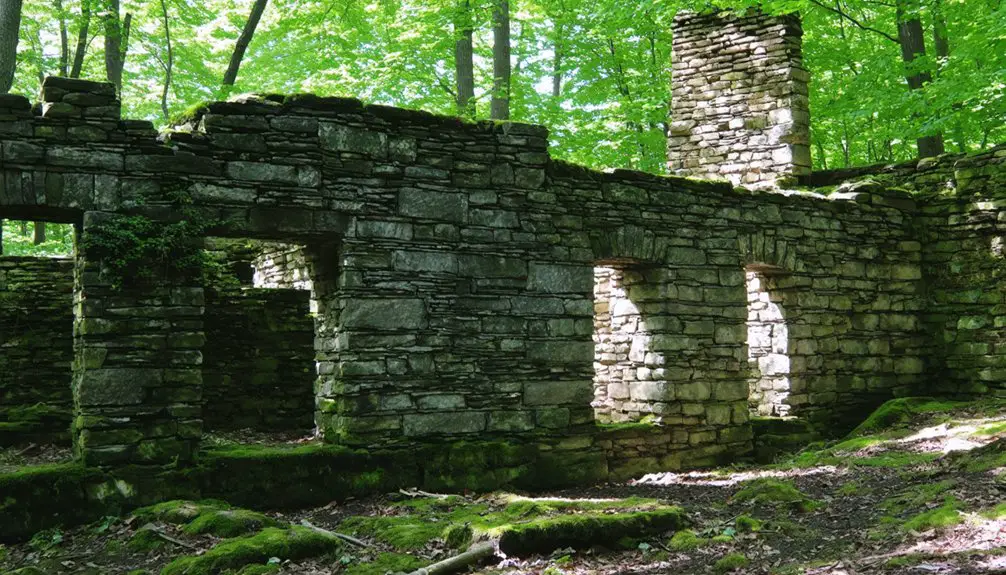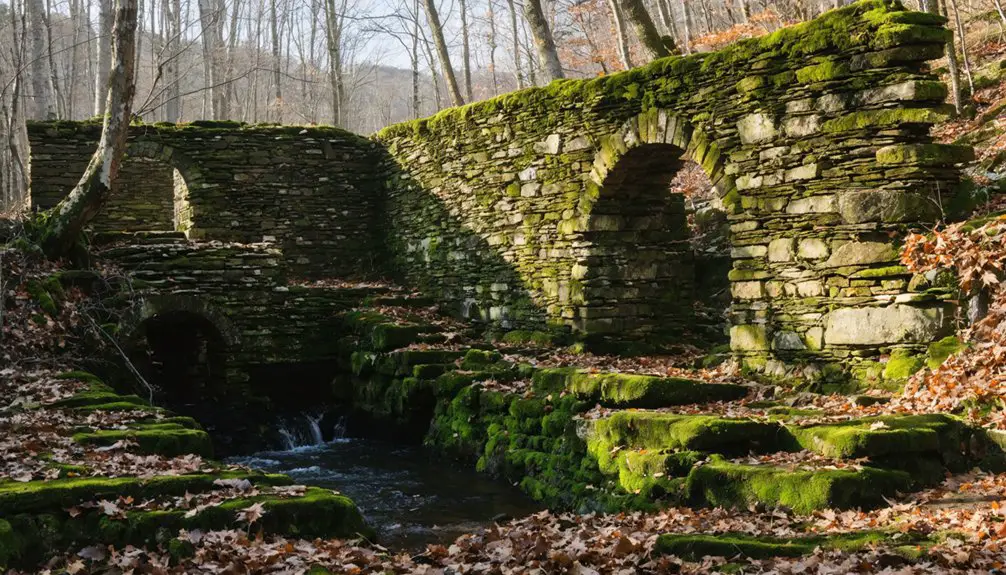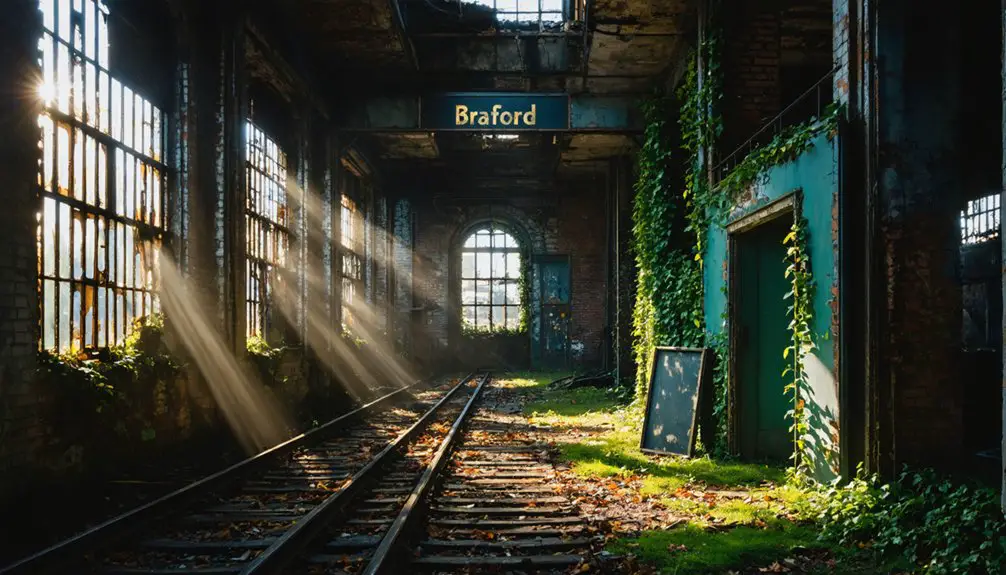You’ll discover Hanton City, a mysterious abandoned colonial settlement deep in Smithfield’s woods. Established by three English families after King Philip’s War in the late 1600s, this self-sufficient farming community thrived until its puzzling decline in the early 1800s. Today, you can explore roughly a dozen stone foundations, an old dam, and the nearby Alfred Smith Cemetery. Local legends of loyalist exiles, mass disappearances, and paranormal activity add intrigue to this forgotten piece of Rhode Island history.
Key Takeaways
- Hanton City is an abandoned colonial settlement in Smithfield, Rhode Island, established in the late 1600s by three English families.
- The ghost town contains roughly twelve colonial-era stone foundations and ruins scattered throughout a wooded area.
- Settlers abandoned the isolated community in the early 1800s due to extreme social isolation and limited economic opportunities.
- The site is accessible via a three-quarter mile hike and features the historic Alfred Smith Cemetery nearby.
- Local legends include stories of banished loyalists, mysterious disappearances, and paranormal activity around the ruins.
The Hidden Colonial Settlement in Smithfield Woods
Nestled deep within the heavily wooded terrain of modern-day Smithfield, Rhode Island, lies a remarkable colonial settlement that offers a window into New England’s early European habitation.
The period following King Philip’s War in 1675-1676 opened this area to colonial settlement after Native American tribes were defeated and displaced.
You’ll find this hidden history along the historic Great Road, where archaeological traces reveal the story of colonial agriculture and frontier life from the late 1600s through the 1700s.
The settlement’s scattered clearings and foundation remnants paint a picture of resourceful farmers and homesteaders who carved out their existence on the edge of civilization.
Through crumbling stones and worn paths, we glimpse the determined settlers who tamed wilderness into farmland at civilization’s edge.
While no buildings remain standing today, the site represents an important shift period when European settlers gradually transformed Native American hunting grounds into a patchwork of small farms and homesteads, creating the rural New England landscape that we understand today.
This historical site is one of several locations sharing the place name Smithfield, requiring careful distinction from other similarly named settlements across the country.
Origins and Early Settlement History
Three English families – the Paines, Hantons, and Shippees – established this remote settlement in the late 1600s after receiving land grants for their service in King Philip’s War (1675-1676).
They chose an isolated location away from main Smithfield, creating a self-sufficient farming community that reflected typical New England settlement patterns of the era.
You’ll find evidence of their resourcefulness in the stone-built structures and agricultural layout they created, adapting to the heavily wooded terrain. Today, visitors can still see the remains of a stone wall still visible.
Cultural influences suggest possible Loyalist sympathies among the settlers, with theories pointing to exiled Tories from Newport joining the community.
The settlement’s isolation from larger colonial centers allowed these families to maintain their traditions, with the Hanton name persisting in the area until around 1900. The residents worked in local stone quarries and crafted handmade shoes to sell in Providence markets.
Life in Hanton City During Colonial Times
You’ll find that daily life in colonial Hanton City revolved around subsistence farming, with families working their isolated plots to grow crops and tend to livestock while supplementing their income through stone quarrying and leatherwork.
The community’s social fabric was woven through bartering goods and services, as evidenced by wedding ceremonies being paid for with meals and rum rather than cash. Three English families established the initial settlement in the mid-1670s, laying the groundwork for the small farming community.
Religious and cultural activities were limited by the settlement’s remote location, though visiting officials would occasionally journey to the community to perform ceremonies and maintain basic civic functions. By approximately 1900, the last remaining residents had abandoned the settlement, leaving behind only stone foundations and burial grounds.
Daily Farming Activities
Rising before dawn, Hanton City’s colonial farmers faced demanding daily routines shaped by New England’s agricultural rhythms. You’d find them tending to livestock first – milking cows, feeding sheep, and checking on horses before heading to the crop fields.
Throughout the growing season, you’d have practiced crop rotation across your stony soil, moving between corn, beans, and squash while letting some fields lie fallow to restore fertility.
Your days centered around the rhythms of livestock management, from grazing cattle near the waterways to shearing sheep for wool production.
Using simple tools like hoes and scythes, you’d clear stones from fields, stack them into boundary walls, and maintain your kitchen garden near the farmhouse.
When harvest time came, you’d gather fruits from your orchard and process grains at the local grist mill. The area was originally known as Wionkhiege by local Native Americans before European settlers established their farms.
Social and Religious Life
Beyond the daily agricultural demands, social and religious life in Hanton City centered around a tight-knit community of English families – the Paines, Hantons, and Shippees.
You’d find social gatherings revolving around practical activities, with communal rituals woven into everyday tasks like stone quarrying and leather tanning.
Without formal church structures, you’d witness religious observances taking place in homes, with traveling ministers occasionally visiting the settlement.
The Alfred Smith Cemetery and local burial grounds served as sacred spaces where families honored their departed.
Wedding ceremonies, officiated by a Justice of the Peace and paid for with meals and rum, brought the community together in celebration.
This barter-based society strengthened social bonds through the exchange of goods and services, creating a self-reliant community that persisted until industrial opportunities drew residents elsewhere.
Mysterious Decline and Abandonment
Although historians have documented various aspects of Hanton City’s existence, the exact reasons behind its decline and eventual abandonment remain shrouded in mystery.
You’ll find evidence suggesting a gradual depopulation that culminated in the early 1800s, marked by large tree growth overtaking former cellar sites. The settlement’s extreme social isolation and limited economic opportunities likely contributed to its downfall.
While the final Hanton family resident reportedly lived there until around 1900, the community’s economic decline had begun long before.
The settlement’s dependence on subsistence farming, combined with possible soil depletion and challenging terrain, made survival increasingly difficult. Without access to evolving regional trade routes and facing persistent geographic isolation, the residents eventually abandoned their homes, leaving only stone foundations and wells as proof of their presence. The rise of mill technology development throughout Rhode Island severely impacted the livelihoods of individual craftsmen and contributed to the village’s decline.
Archaeological Remnants and Structural Remains

You’ll find substantial stone foundations scattered throughout Hanton City’s wooded landscape, offering clear evidence of the settlement’s colonial-era buildings and cellars.
The ruins include multiple house foundations with kitchen cellars, agricultural structures, and boundary walls that paint a picture of a typical New England farming community. Archaeological discoveries have revealed Late Archaic tools dating back thousands of years in the surrounding region.
A particularly notable remnant is the settlement’s old dam, which stands as a testament to the inhabitants’ early water management capabilities and agricultural engineering prowess.
Stone Foundations Reveal History
Hidden beneath layers of New England forest growth, the stone foundations of Smithfield’s ghost town tell a compelling story of colonial life through their architectural remains.
You’ll find evidence of a thriving rural community in the locally sourced fieldstone structures that have outlasted their wooden counterparts. The stone architecture reveals moderately-sized homes with accessible cellars, suggesting a prosperous settlement rather than a poor outpost.
When you explore the site, you’ll discover cellar holes with surviving steps, a standing stone well, and an extensive network of stone walls that once marked property boundaries and contained livestock.
While vegetation now obscures many foundations, these durable remains provide rare physical proof of 17th and 18th-century New England settlement patterns and construction techniques.
Ancient Dam Still Stands
Standing proudly since 1850, the earthen dam at Georgiaville Pond remains one of Smithfield’s most impressive engineering feats.
You’ll find this remarkable structure still performing its original purpose, impounding ninety-two acres of water that once powered the region’s bustling textile mills.
The dam’s history intertwines with Smithfield’s industrial significance, serving as an essential water management system during the manufacturing boom.
Today, you can walk along its high embankment, where carved beech trees and old stone fireplaces tell stories of generations past.
After a major renovation in 1991, the dam continues to stand strong, its spillway feeding into a deep gorge below.
This enduring landmark now offers both a glimpse into Rhode Island’s industrial heritage and a peaceful spot for exploration, with pine-covered islands dotting the expansive pond.
Local Legends and Folklore
Among the most intriguing aspects of Smithfield’s abandoned settlements are the rich legends and folklore that have persisted through generations.
You’ll find the haunting tale of the Snake Man, a mysterious wanderer who died near Noforce Rocks, preserved in Dorothy Whipple’s 1929 essay.
The ghost stories surrounding Hanton City have evolved into complex narratives, from theories of banished loyalists to claims of mass disappearances.
You might encounter reports of paranormal phenomena, including unexplained cold spots and EVPs around the ruins.
While 19th-century newspapers often blurred the line between fact and fiction, historical research has confirmed certain elements of these tales.
The gradual distortion of settler names, like Herendin to Hanton, reflects how oral traditions have shaped the ghostly legacy of this mysterious settlement.
Exploring the Lost City Today
Deep within Smithfield’s dense woodlands, you’ll find the remnants of Hanton City accessible via a challenging three-quarter mile hike from the trailhead at 70 W. Reservoir Road.
As you venture along the overgrown path, nature reclaiming the settlement becomes evident through stone foundations barely visible beneath thick vegetation.
You’ll discover roughly a dozen homestead ruins scattered throughout the area, with ghostly encounters limited to crumbling stone walls and a solitary cellar foundation in a clearing.
The Alfred Smith Cemetery lies nearby, though respectful distance should be maintained.
Navigation proves most successful during winter months when foliage thins, revealing traces of old infrastructure and colonial-era stonework.
Winter exploration offers clearer views of colonial ruins, as bare branches expose centuries-old stone structures beneath.
Consider photographing landmarks to maintain your bearings, as the swampy terrain and lack of clear signage can disorient even experienced hikers.
Cultural and Historical Significance
While its crumbling ruins may appear modest today, Hanton City holds profound significance as a time capsule of colonial New England life.
You’ll find its historical connections deeply woven into the region’s pivotal moments, from King Philip’s War to the Revolutionary period. The settlement’s isolation fostered a distinct cultural memory that’s preserved in local oral histories and early 20th-century documentation.
Beyond its physical remnants, you’re looking at a powerful example of colonial-era settlement patterns and rural life.
The stone foundations, walls, and Alfred Smith Cemetery tell the story of self-reliant farming families who shaped the land. Whether they were war veterans, loyal colonists, or Revolutionary-era Loyalists, these settlers left behind a legacy that illuminates the complex social fabric of early American history.
Preservation Challenges and Future Outlook
As harsh New England weather cycles continue their relentless assault on Hanton City’s remnants, preservation efforts face mounting challenges.
You’ll find that traditional preservation strategies struggle against the site’s unique obstacles, from glacial soil conditions to aggressive forest reclamation. The Historical Preservation Commission‘s limited resources can’t adequately address these widespread ghost town ruins.
Key preservation hurdles include:
- Natural degradation accelerated by freeze-thaw cycles and root systems
- Minimal community involvement due to remote location and lack of public awareness
- Competition for resources with more intact historical sites
Without increased local support and specialized conservation approaches, you’re witnessing these historical treasures slowly disappear.
The site’s future depends on developing innovative preservation methods while building stronger community connections to protect these valuable cultural resources.
Frequently Asked Questions
Are There Any Documented Photographs of Hanton City Before Its Abandonment?
You won’t find any documented photographs of Hanton City before abandonment, since the settlement’s historical significance predates photography – it was abandoned in the early 1800s before cameras were invented.
What Happened to the Personal Belongings of the Last Residents?
Like fading Instagram stories, their abandoned possessions likely decomposed on-site or were carried away by departing families. You’ll find last memories buried beneath forest growth, never formally excavated or documented.
Were There Any Schools or Churches Built in Hanton City?
You won’t find evidence of schools or churches in Hanton City’s historical record. The community’s limited size and resources meant residents likely relied on Smithfield’s institutions for their educational and spiritual needs.
Have Any Artifacts From Daily Colonial Life Been Recovered?
Drawing a blank on this one – while stone foundations and farm walls remain intact, there’s little documented evidence of colonial tools or daily life artifacts being recovered from Hanton City’s grounds.
Did Any Descendants of Original Hanton City Settlers Remain in Smithfield?
Your search for Hanton City descendants suggests they left Smithfield by the early 1900s, though Thomas Hanton and his sister were the last known residents from original settler families there.
References
- https://en.wikipedia.org/wiki/Hanton_City
- https://www.youtube.com/watch?v=kpy7zlXYrAU
- https://weird-island.simplecast.com/episodes/57-ghost-town-hanton-city-ky53imy0
- https://www.youtube.com/watch?v=mfZyBEGitv0
- https://smithapplebyhouse.org/are-there-ghosts-in-smithfields-haunted-city/
- https://en.wikipedia.org/wiki/Smithfield
- https://preservation.ri.gov/sites/g/files/xkgbur406/files/pdfs_zips_downloads/survey_pdfs/smithfield.pdf
- https://www.britannica.com/place/Rhode-Island-state/History
- https://en.wikipedia.org/wiki/List_of_early_settlers_of_Rhode_Island
- https://www.smithfieldri.gov/our-town/town-history



